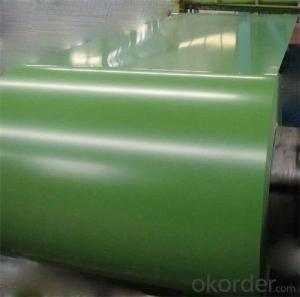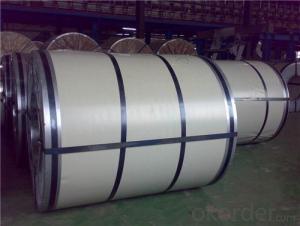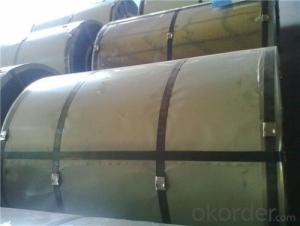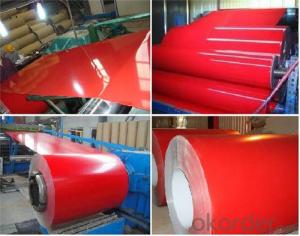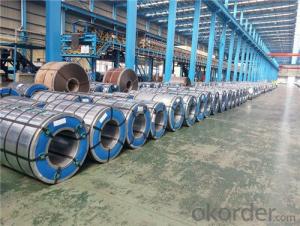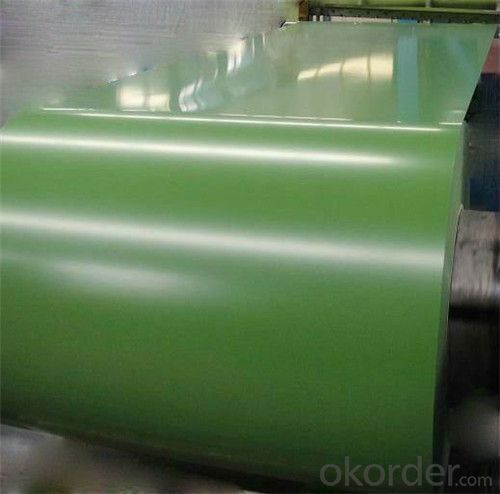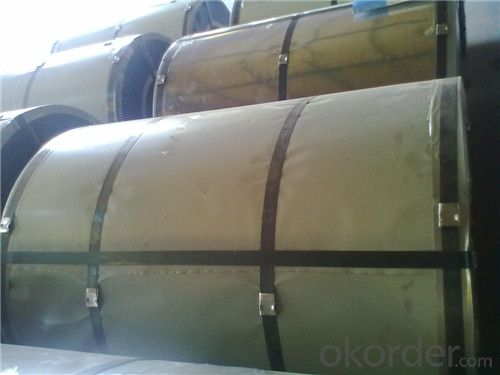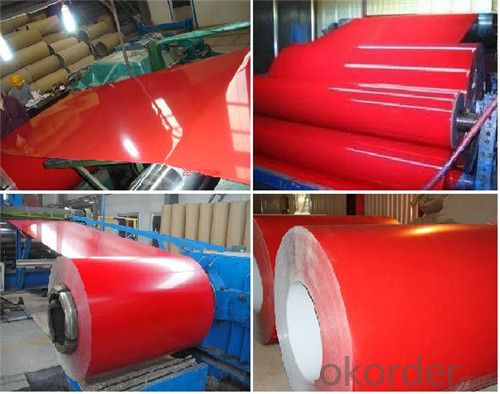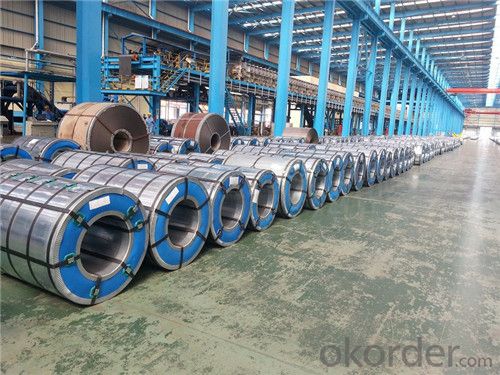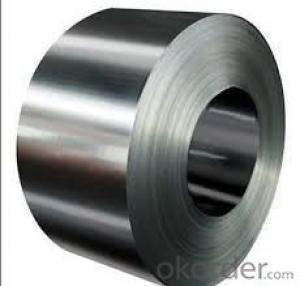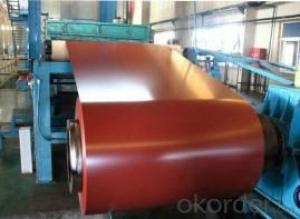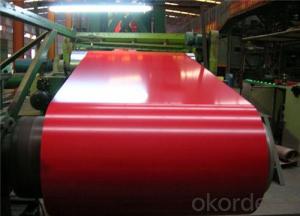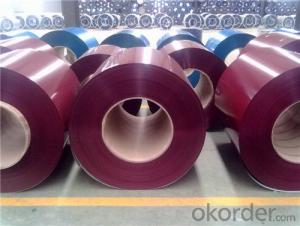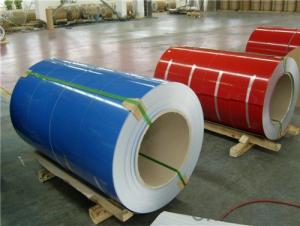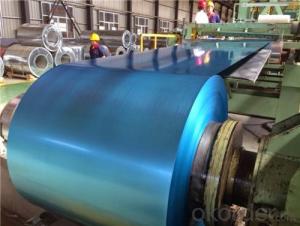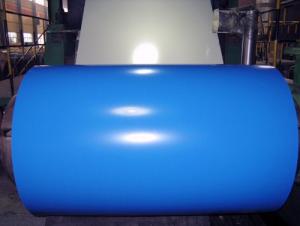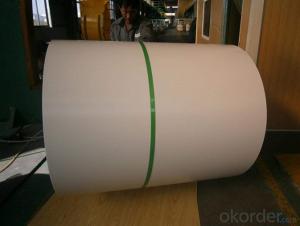BMT AZ45 Prepainted Rolled Steel Coil for Construction
- Loading Port:
- Shanghai
- Payment Terms:
- TT OR LC
- Min Order Qty:
- 50 m.t.
- Supply Capability:
- 30000 m.t./month
OKorder Service Pledge
OKorder Financial Service
You Might Also Like
Structure of BMT AZ45 Prepainted Rolled Steel Coil for Construction
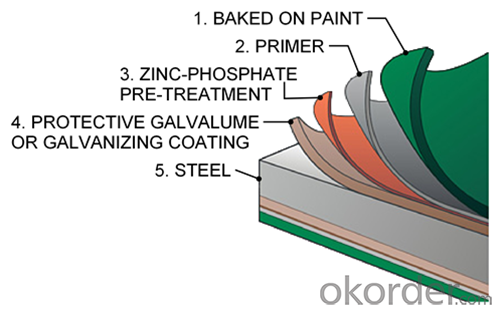
Description of BMT AZ45 Prepainted Rolled Steel Coil for Construction
BMT Prepainted Rolled Steel Coil is a kind of coated steel coil/sheet. With the cold rolled steel of different strength and thickness as substrate, it is produced through applying Zn coating on both faces by hot dip process. Its surface has bright silver color and regular embossed-like figure, which are highly decorative.
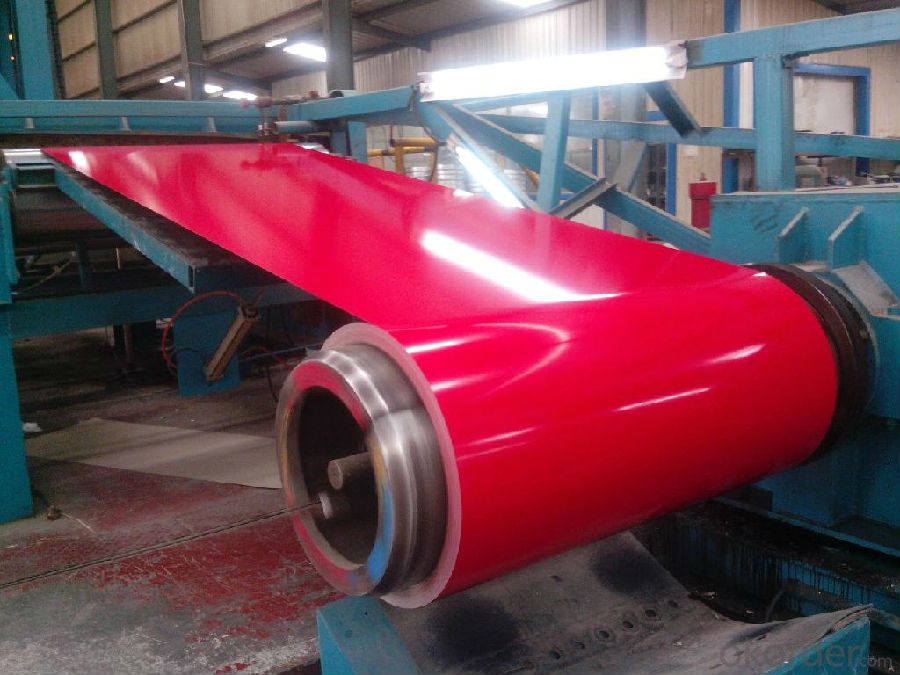
Main Feature of BMT AZ45 Prepainted Rolled Steel Coil for Construction
1.Corrosion resistance: It mainly depends on the aluminum protection. When the zinc being worn, the aluminum will form a dense layer of aluminum oxide, resist corrosion material to prevent further corrosion inside.
2. Heat reflective: Galvanized steel plate heat-reflective high rate is twice as galvanized steel, often used to make insulation materials.
3. Economy: Because density of 55% AL-Zn is smaller than the density of Zn, so in the same weight and thickness of Galvanized zinc layer, aluminum-zinc steel plate is larger area more than 3% of galvanized steel sheet.
Applications of BMT AZ45 Prepainted Rolled Steel Coil for Construction
1. Construction and building: roofing; ventilating duct; handrail; partition panel
2. Electric appliance: refrigerator; washing machine; refrigerator..
3. Transportation: oil tank; road sign; etc.
4.Agriculture:barn; etc.
5. Others: vending machine; game machine; etc.
Specifications of BMT AZ45 Prepainted Rolled Steel Coil for Construction
Product | BMT AZ45 Prepainted Rolled Steel Coil for Construction |
Material Grade | SGCC / SGCH / DX51D+AZ, etc |
Thickness | 0.2-3.5mm |
Width | 400-1250mm |
Tolerance | Thickness: +/-0.02mm , Width:+/-2mm |
Zinc-coating | AZ40-90g/m2 |
Technique | Raw material: Hot rolled steel coil> Cold rolled>hot dipped galvalume |
Surface | Dried, Chromated, Unoiled |
Spangle | Regular spangle , small spangle, zero spangle |
ID | 508MM 610MM |
Coil weight | 3-25MT max |
Export package | Cardboard inner sleeves, Waterproof paper, galvanized steel covered and steel strip packed |
FAQ of BMT AZ45 Prepainted Rolled Steel Coil for Construction
We have organized several common questions for our clients,may help you sincerely:
1. What is your MOQ ?
Our MOQ is 50mt. And we could offer more discount if you order like 1000 tons and more. Furthermore, the more appropriate payment term your can offer, the better price we can provide.
2. How long can we receive the product after purchasing?
Usually it is within thirty working days after received buyer’s advance payment or LC. We will arrange the factory manufacturing as soon as possible. The cargo readiness usually takes 20- 25 days, but the shipment will depend on the vessel situation.
3. How do you guarantee the quality of the products?
We have established the international advanced quality management system ,every link from raw material to final product we have strict quality test;We resolutely put an end to unqualified products flowing into the market. At the same time, we will provide necessary follow-up service assurance.
4. What different between PVDF and PE?
PVDF is the most advanced painting in construction industry, it is with high corrosion resistance and color retention, and the life time could last to 20-25 years. Currently, PE is the most widely-used painting in the color coated steel coils. It is characterized by good overall performance, and high economic as well
- Q: How are steel coils used in the manufacturing of mining equipment?
- Steel coils are used in the manufacturing of mining equipment for various purposes, such as forming the structural components, building frames, and creating durable and robust machinery. These coils are often shaped, cut, and welded to construct mining machinery that can withstand the harsh conditions and heavy-duty operations in the mining industry.
- Q: I'm building a single-speed commuter bike and I was wondering what the advantages and disadvantages of steel and alloy wheels are. Any experts out there who can give me specifics for each kind?
- Steel wheels are at the lowest cost and quality end of bike equipment. If you're even thinking of buying a cheapo bike with steel wheels - don't. Steel wheels are poor quality and therefore weaker than an OK alum rim. They are heavier, braking isn't as good, won't stay true as long. Alum wheels are extruded, not cast, and are better in every way. They cost more is the only down side.
- Q: How are steel coils used in the production of electrical conduits?
- Several techniques are employed in the production of electrical conduits using steel coils. Firstly, the raw material for manufacturing electrical conduits is steel coils. These coils are composed of specially processed and formed high-quality steel, which is transformed into a continuous strip of considerable length. Once the steel coils are acquired, they are fed into a machine known as a slitter. This machine swiftly slices the coils into narrower strips of the desired width, which will function as the foundational material for the electrical conduits. The subsequent step involves shaping the steel strips into the desired conduit shape. This is accomplished by guiding the strips through a series of rollers and various shaping tools. Gradually, the steel strips take on the round or rectangular shape of the conduit as the rollers exert pressure and manipulate the strip until it reaches the desired form. After the shaping process, the ends of the steel strips are fused together to create a seamless conduit. This welding procedure ensures that the conduit possesses a structure devoid of any seams, a vital characteristic for its functionality and durability. Once the conduits have been shaped and welded, they undergo additional processing to enhance their properties. This may involve galvanizing, whereby a protective layer of zinc is applied to the conduits to shield them from corrosion. This additional layer significantly prolongs the lifespan of the conduits, rendering them suitable for a wide range of electrical applications. In summary, steel coils play a crucial role in the production of electrical conduits. These coils serve as the raw material that is shaped, welded, and further processed to create the final product. The utilization of steel coils ensures that the electrical conduits are robust, long-lasting, and capable of withstanding the rigorous demands of electrical installations.
- Q: How do steel coils contribute to energy efficiency in transportation?
- There are several ways in which steel coils help improve energy efficiency in transportation. To begin with, steel coils are lightweight and have a high strength-to-weight ratio. This means that they require less steel material to carry the same load compared to other materials like wood or concrete. As a result, the overall weight of the transport vehicle is reduced, leading to lower fuel consumption and emissions. Furthermore, steel coils are extremely durable and can withstand harsh transportation conditions. They are highly resistant to corrosion, impact, and fatigue, ensuring a longer lifespan for the transport vehicle. This durability reduces the need for frequent repairs or replacements, resulting in reduced energy consumption and material waste. Moreover, steel coils are easily handled and transported. Due to their compact and standardized size, they can be effortlessly loaded and unloaded from trucks, trains, or ships. This efficiency in handling reduces the time and energy required for loading and unloading operations, ultimately increasing overall transportation efficiency. Additionally, steel coils can be efficiently stacked and stored, maximizing the utilization of available space in transport vehicles. This reduces the number of trips needed to transport the same amount of goods, resulting in less energy consumption and lower transportation costs. Lastly, steel is a highly recyclable material. At the end of their life cycle, steel coils can be easily recycled and used to produce new steel products. This reduces the demand for raw materials and the energy required for manufacturing new products, thereby contributing to overall energy efficiency in transportation. In conclusion, steel coils play a crucial role in enhancing energy efficiency in transportation. Their lightweight, durable, easy-to-handle, and recyclable nature leads to decreased fuel consumption, lower emissions, reduced maintenance needs, efficient use of space, and minimized material waste. All of these factors contribute to a more sustainable and energy-efficient transportation system.
- Q: How are steel coils used in the production of steel pipes?
- Steel pipes rely on steel coils as a vital element in their production. These coils serve as the primary material for manufacturing the pipes. The initial phase of the process involves unwinding the steel coil and introducing it into a machine referred to as a slitter. The slitter then cuts the coil into narrower strips of the desired width. This width plays a crucial role as it determines the diameter of the resulting steel pipes. Once the steel coil has been sliced into strips, the subsequent step is to feed these strips into another machine known as a forming mill. The forming mill gradually shapes the strips into a cylindrical form by passing them through a sequence of rollers. These rollers apply pressure and bend the strips until they assume the shape of a pipe. To ensure the pipes' durability and strength, they undergo a welding procedure. The ends of the strip are heated and fused together using a high-frequency electric current, creating a seamless weld along the entire length of the pipe. This weld provides structural integrity and prevents any leakage or weak points in the pipe. After the welding process, the pipes undergo a sizing and shaping procedure. They are passed through additional rollers, gradually reshaping them to achieve the desired dimensions, including the final outer diameter and wall thickness. Finally, the pipes are cut to the desired length and undergo various finishing procedures, such as straightening, testing, and coating. These finishing steps guarantee that the pipes meet the required specifications and are ready for use in various applications, such as plumbing, construction, and the oil and gas industries. In conclusion, steel coils serve as the foundation for the production of steel pipes. They are slit, formed, welded, sized, shaped, and finished to create robust and high-quality pipes suitable for diverse industries.
- Q: Im looking to learn guitar and i was wondering if steel strings are too hard to use as a beginner. I am also self teaching so any good lesson books/starting guitar recommendations are welcome !! thanks.
- Steel strings are fine for a beginner. I learned to play on Steel strings and I have always preferred them to nylon strings.
- Q: What are the common methods of inspecting steel coils for quality control?
- The common methods of inspecting steel coils for quality control include visual inspection, dimensional measurement, surface inspection, and mechanical testing. Visual inspection involves checking for any visible defects or abnormalities such as cracks, dents, or scratches. Dimensional measurement ensures that the coils meet the specified size and thickness requirements. Surface inspection involves examining the surface finish, cleanliness, and coating integrity. Mechanical testing involves conducting various tests to assess the strength, hardness, and other mechanical properties of the steel coils. These methods collectively ensure that the steel coils meet the required quality standards.
- Q: What are the best types of steel for swords
- Don't know too much but I know combat grade katanas are made out of folded carbon-steel. Could also look into industrial steel grading systems if you are looking for something to show off at a martial arts tournament or something.
- Q: Can steel coils be stored in unheated warehouses?
- Yes, steel coils can be stored in unheated warehouses as long as proper precautions are taken to prevent moisture and corrosion.
- Q: I'm quite confused...i watched all of steel angel kurumi (the 28 episodes) and then continued to steel angel kurumi zero. it was an entire different story line with only the steel angels being the same. the world is different the guys are different, and there is a new character. Even the humor is gone. its like a whole different series. So what gives, what is the relationship between them?
- Steel Angel Zero is an OVA (Original Video Animation), a very short animation that went straight to DVD. It probably was written because Kurumi was so popular, and the producer wanted to check the waters for whether they should make a second season. It's pretty hard to keep track of what anime is which, especially in the more popular series. If you think Zero is worth zero, try Steel Angel Kurumi 2 (anime, 12 episodes), and Steel Angel Kurumi Encore (OVA, 4 episodes) as well.
Send your message to us
BMT AZ45 Prepainted Rolled Steel Coil for Construction
- Loading Port:
- Shanghai
- Payment Terms:
- TT OR LC
- Min Order Qty:
- 50 m.t.
- Supply Capability:
- 30000 m.t./month
OKorder Service Pledge
OKorder Financial Service
Similar products
Hot products
Hot Searches
Related keywords
